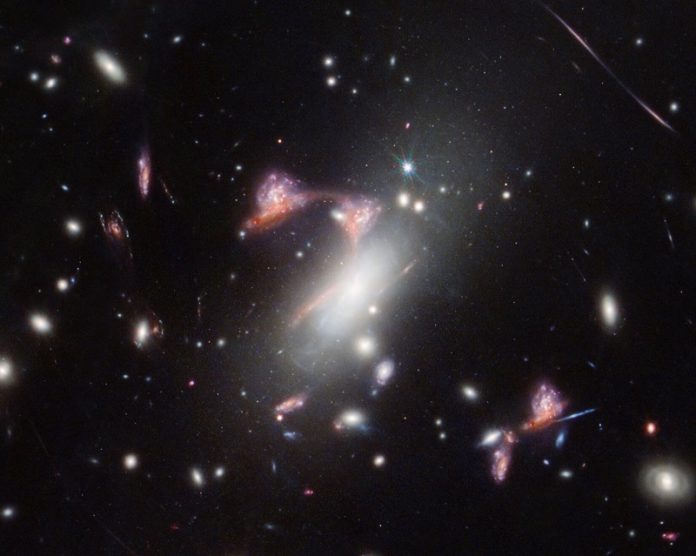
Astronomers using NASA’s James Webb Space Telescope have discovered a rare and intriguing cosmic formation that looks like a question mark in space.
This shape is the result of a unique alignment of galaxies that occurred over 7 billion years ago.
The findings were recently published in the Monthly Notices of the Royal Astronomical Society.
This cosmic question mark was spotted while astronomers were observing a distant galaxy cluster called MACS-J0417.5–1154.
The cluster is so massive that it bends and warps the space around it, a phenomenon known as gravitational lensing.
This warping effect acts like a magnifying glass, allowing astronomers to see more distant galaxies in greater detail, though the distortion often causes the galaxies to appear stretched and smeared across the sky.
In this case, the James Webb Space Telescope revealed a red, dusty galaxy and a spiral galaxy interacting with each other.
The spiral galaxy had been previously observed by the Hubble Space Telescope, but the red galaxy only became visible with Webb’s infrared capabilities. Unlike Hubble, which detects shorter wavelengths of light that can get blocked by cosmic dust, Webb can see through the dust to reveal hidden details.
The alignment of these galaxies, combined with the warping effect of the galaxy cluster, created the unique “question mark” shape in the sky. Four images of the interacting galaxies form the curved part of the question mark, while an unrelated galaxy appears at the bottom, creating the “dot” of the question mark.
This rare alignment is known as a hyperbolic umbilic gravitational lens, something that has only been observed three or four times in the universe.
“This discovery is exciting because it shows how powerful the Webb telescope is and opens the door for finding more of these rare cosmic phenomena,” said astronomer Guillaume Desprez from Saint Mary’s University in Canada, who is part of the research team.
In addition to the unique shape, the researchers also studied how these galaxies are forming new stars. By combining data from both Hubble’s ultraviolet light and Webb’s infrared light, the team was able to identify active star formation in several compact regions of both galaxies.
According to Vicente Estrada-Carpenter, another researcher from Saint Mary’s University, these galaxies are likely starting to interact with each other, with gas from both galaxies colliding and triggering new star formation.
Interestingly, despite the early stages of this galactic interaction, neither galaxy’s shape appears significantly disrupted. This suggests that the galaxies are just beginning to influence one another.
“This discovery gives us a glimpse of what our own Milky Way galaxy might have looked like billions of years ago, during its teenage years when star formation was at its peak,” said astronomer Marcin Sawicki, also from Saint Mary’s University.
The data for this study came from the Canadian NIRISS Unbiased Cluster Survey (CANUCS), using Webb’s Near-Infrared Imager and Slitless Spectrograph (NIRISS) instrument. These findings help astronomers better understand how galaxies evolved during the history of the universe and offer a rare look at the early stages of galactic collisions.
In addition to its scientific significance, the cosmic question mark is simply a striking image. “This is one of those amazing discoveries that inspires people to get into astronomy,” said Sawicki.



